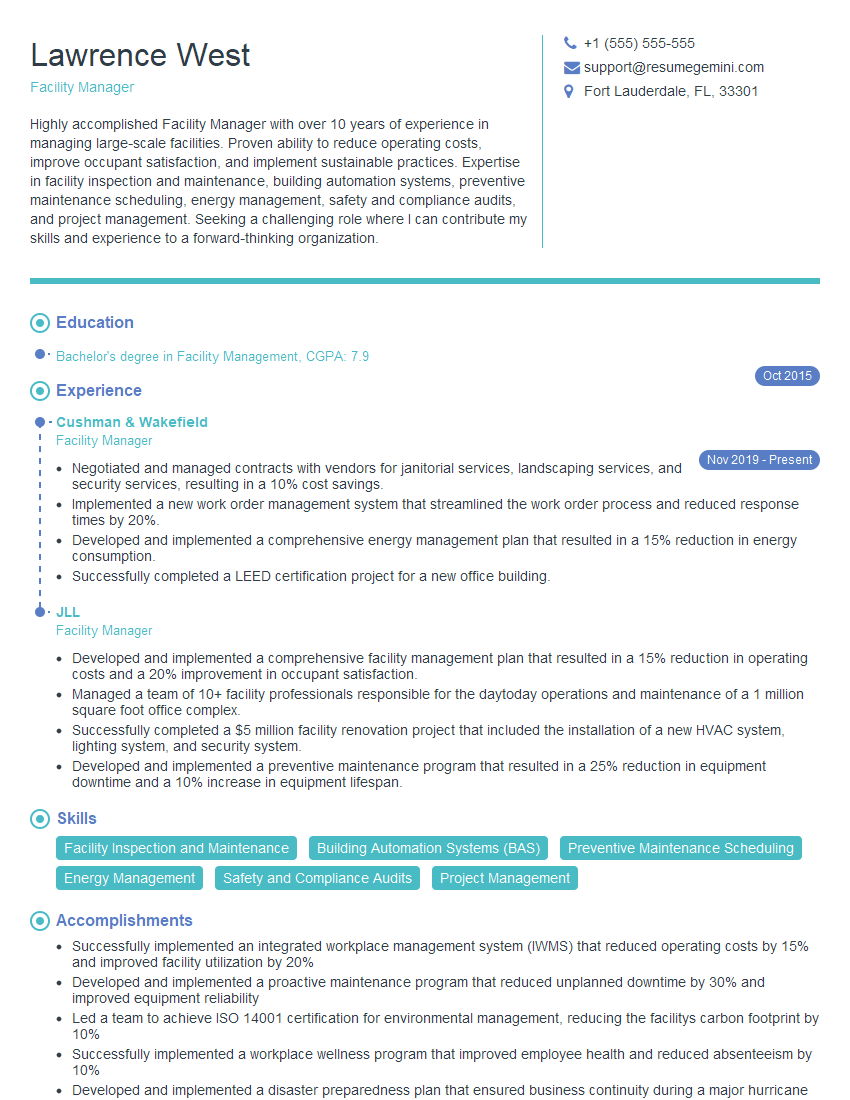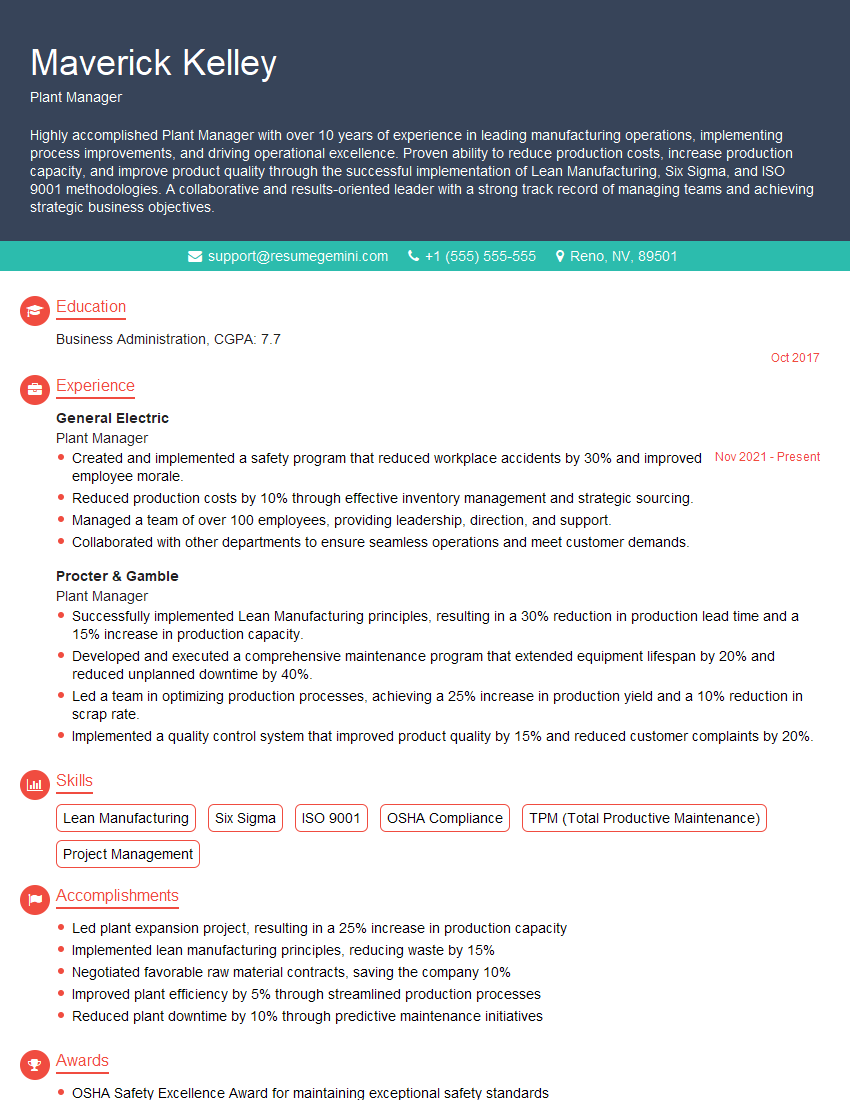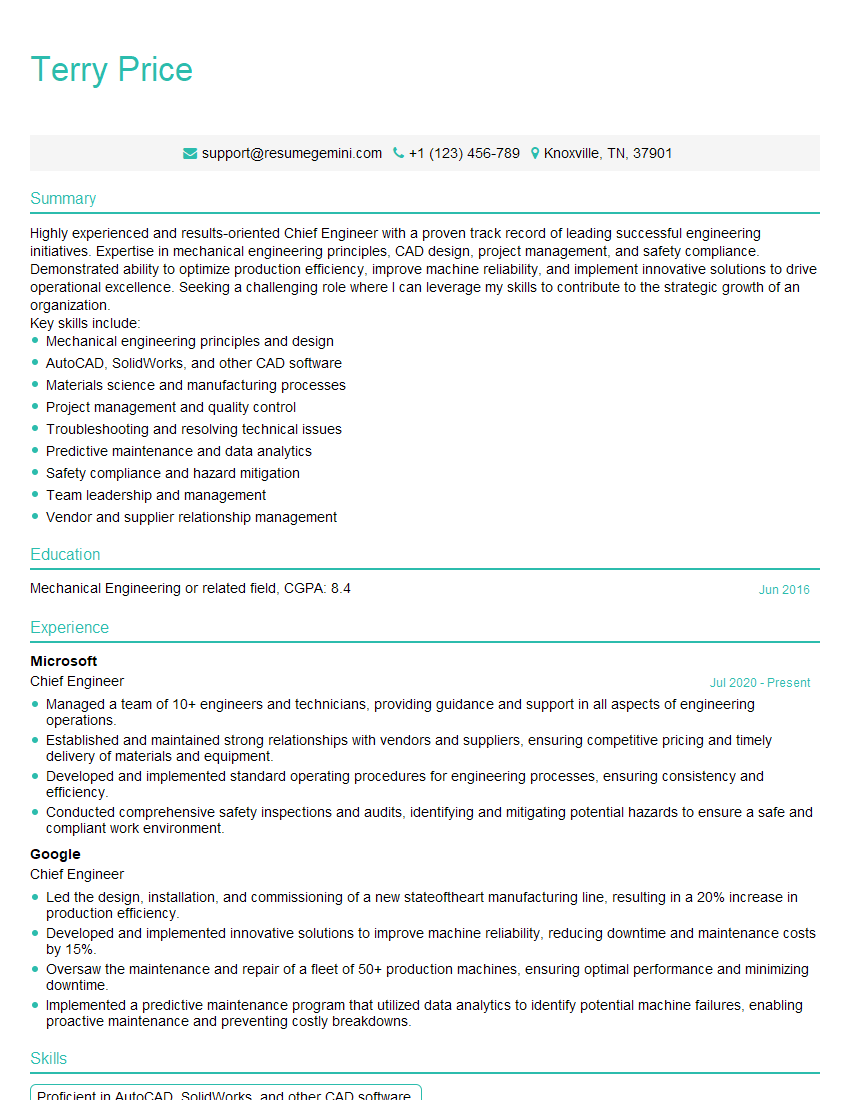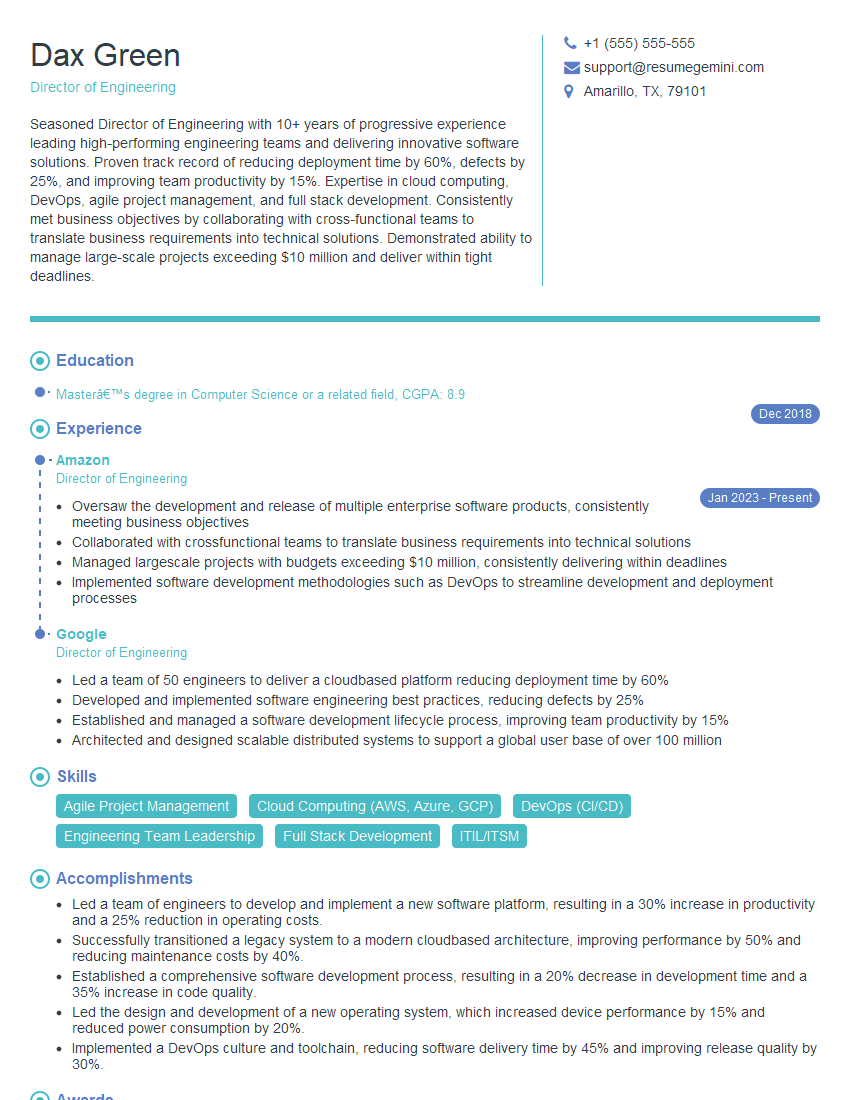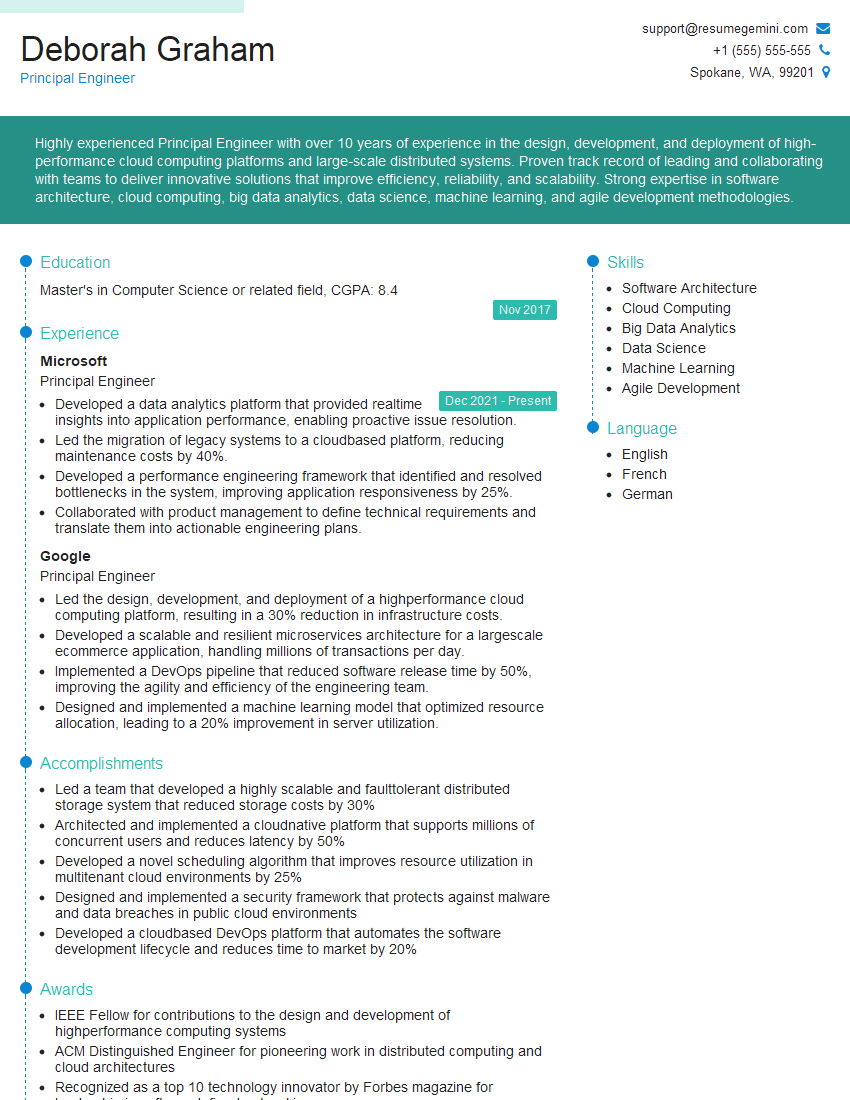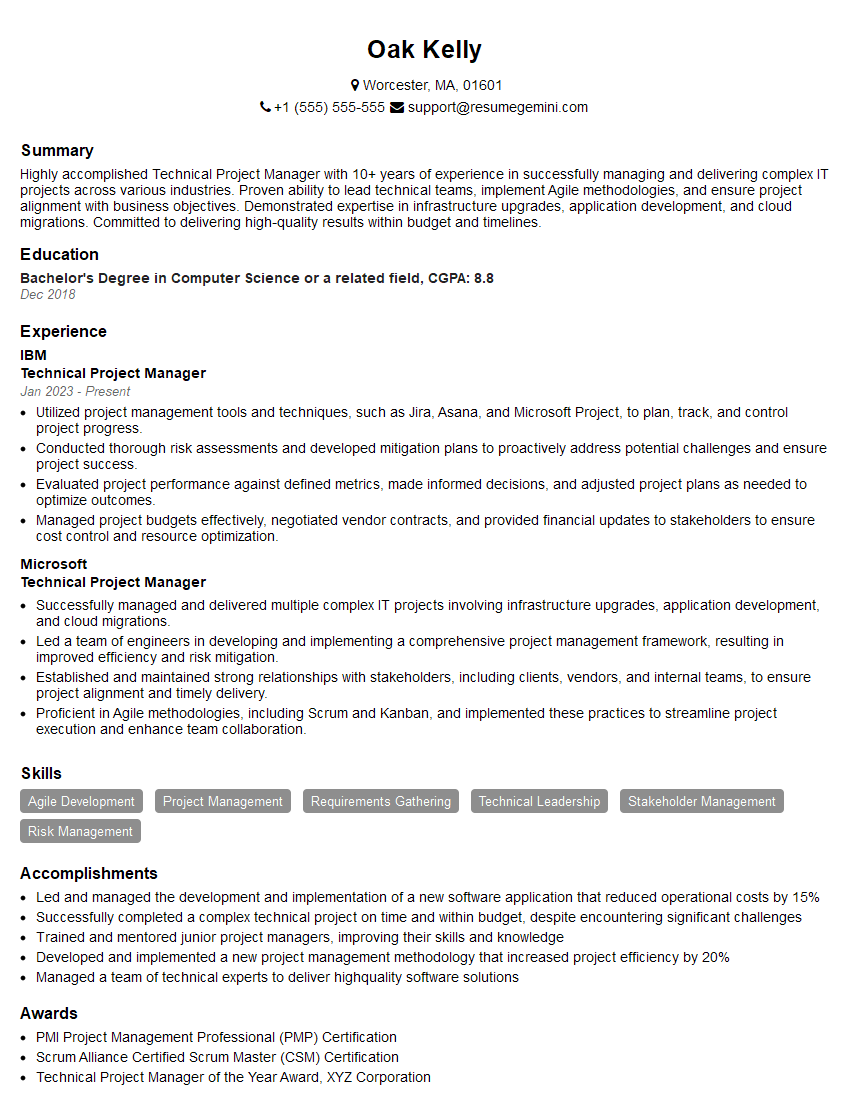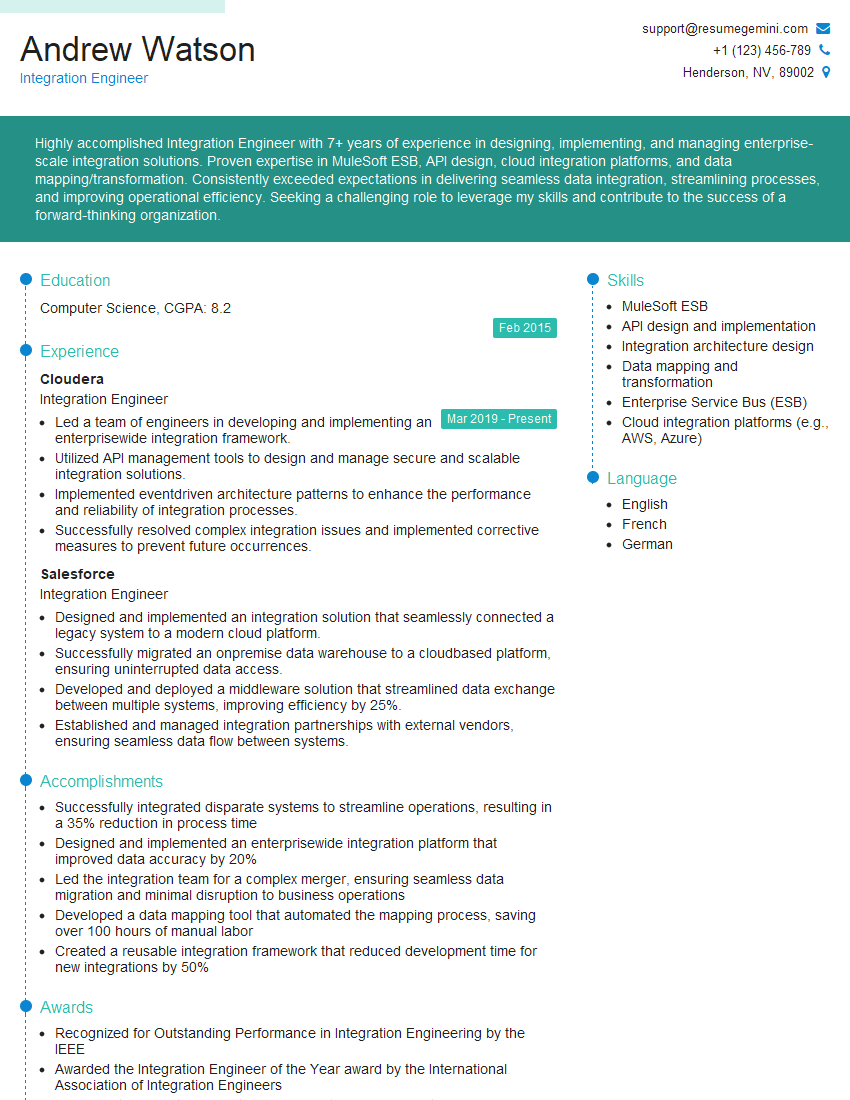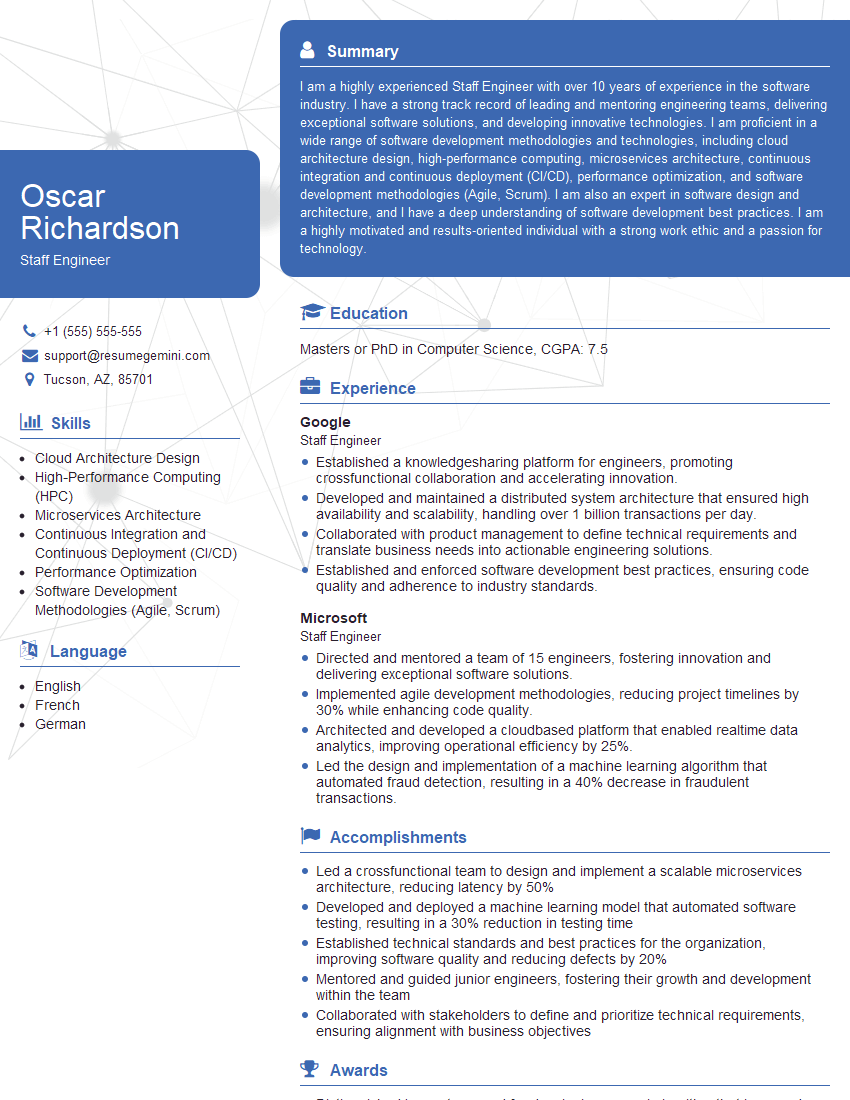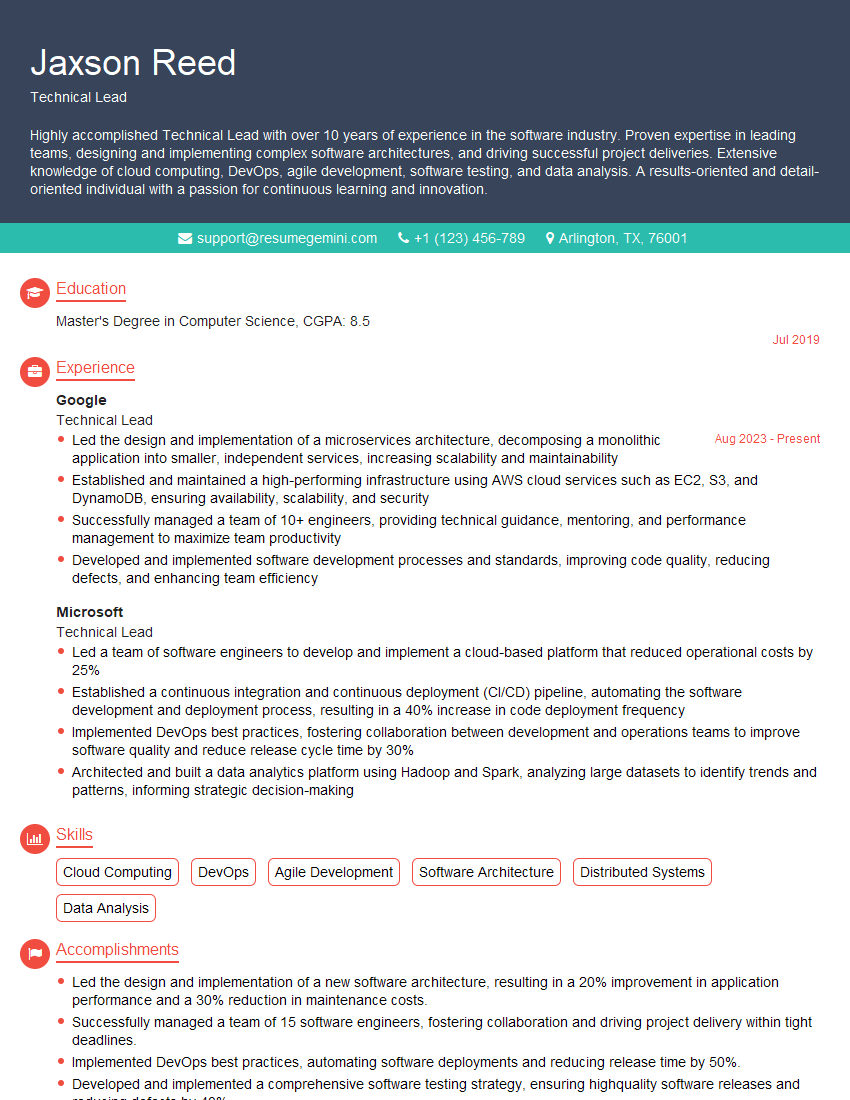Are you ready to stand out in your next interview? Understanding and preparing for Teamwork and Collaboration with Engineers and Operators interview questions is a game-changer. In this blog, we’ve compiled key questions and expert advice to help you showcase your skills with confidence and precision. Let’s get started on your journey to acing the interview.
Questions Asked in Teamwork and Collaboration with Engineers and Operators Interview
Q 1. Describe your experience working with cross-functional engineering and operations teams.
My experience working with cross-functional engineering and operations teams spans over eight years, encompassing various projects within the telecommunications and software development sectors. I’ve consistently worked in environments requiring close collaboration between software engineers, network engineers, system administrators, and operations personnel. This involved coordinating development sprints, deploying new features, troubleshooting production issues, and ensuring seamless service delivery. A key aspect of this has been understanding the different perspectives and priorities of each team, appreciating that engineering focuses on building and innovating while operations focuses on maintaining stability and uptime.
For example, in a recent project involving a major software upgrade, I facilitated daily stand-up meetings between engineering and operations, ensuring transparent communication regarding development progress, potential risks, and deployment plans. This proactive approach minimized surprises and fostered a collaborative environment where issues could be addressed promptly.
Q 2. How have you resolved conflicts between engineering and operations personnel?
Resolving conflicts between engineering and operations often involves understanding the root cause. Disagreements frequently stem from differing priorities – engineers may prioritize new features, while operations focuses on system stability. My approach involves facilitating open dialogue, encouraging active listening, and identifying common goals. I often use a structured approach:
- Identify the core issue: Clearly define the point of contention, avoiding emotional language.
- Gather perspectives: Individually speak with each party to understand their concerns and reasoning.
- Find common ground: Focus on shared objectives, such as delivering a high-quality product or ensuring customer satisfaction.
- Develop a compromise: Collaboratively create a solution that addresses the concerns of both sides. This might involve prioritizing tasks differently or implementing a phased rollout.
- Document the agreement: Clearly outline the agreed-upon solution and responsibilities to prevent future misunderstandings.
In one instance, a conflict arose over the deployment schedule of a new feature. Engineering wanted a rapid rollout, while operations expressed concerns about potential instability. By facilitating a discussion, we agreed on a phased rollout to a smaller subset of users first, allowing for monitoring and adjustments before a full deployment, addressing both concerns.
Q 3. Explain a time you had to negotiate technical solutions with limited resources.
During a project with limited budget and time constraints, we needed to develop a solution for automated testing. The ideal solution involved a sophisticated, commercial testing platform, but the budget didn’t allow it. I facilitated a brainstorming session with the team, focusing on alternative solutions. We explored open-source alternatives, identifying one that met most of our requirements. To bridge the gap in functionality, we leveraged the skills within the team – a junior engineer with experience in scripting helped automate some tasks that were originally intended for the commercial platform. This collaborative approach, focusing on resourcefulness and leveraging existing skillsets, helped us achieve our testing goals without exceeding our budget.
Q 4. How do you ensure effective communication within an engineering and operations team?
Effective communication is paramount. I utilize a multi-pronged strategy:
- Regular meetings: Daily stand-ups for updates, weekly meetings for planning and progress reviews.
- Collaborative tools: Using platforms like Slack for quick updates, Jira for task management and tracking, and Confluence for documentation.
- Clear documentation: Maintaining comprehensive documentation of processes, decisions, and technical specifications.
- Open communication channels: Encouraging open dialogue and feedback, ensuring everyone feels comfortable voicing concerns or suggestions.
- Visual communication: Using dashboards and charts to visualize progress and identify potential roadblocks.
For instance, using a Kanban board in Jira allows everyone to see the status of every task, promoting transparency and accountability.
Q 5. What methodologies have you used to improve teamwork and collaboration within your team?
To improve teamwork and collaboration, I’ve implemented several methodologies:
- Agile methodologies: Scrum and Kanban have been particularly effective in promoting iterative development, continuous feedback, and cross-functional collaboration.
- Retrospectives: Regularly conducting retrospectives to identify areas for improvement in our processes and working relationships.
- Cross-training: Encouraging engineers and operators to learn about each other’s roles and responsibilities to foster a deeper understanding and empathy.
- Team-building activities: Organizing informal events to strengthen team cohesion and improve communication outside of work tasks.
For example, incorporating sprint retrospectives allowed us to identify recurring issues in our workflow and implement improvements, such as better task estimation and clearer communication protocols.
Q 6. Describe your experience with using project management tools to facilitate teamwork.
I have extensive experience with various project management tools, including Jira, Asana, and Trello. These tools have been instrumental in facilitating teamwork by providing centralized platforms for task management, progress tracking, and communication. Jira, in particular, has been invaluable for managing complex projects involving numerous engineers and operators. Its features, such as Kanban boards, sprint planning tools, and issue tracking, allow for transparent tracking of progress, efficient task assignment, and quick identification of potential roadblocks. For example, using Jira’s workflow automation capabilities, we’ve streamlined the process of assigning tasks, ensuring that the right people are notified at the right time.
Q 7. How do you handle disagreements regarding technical priorities between engineering and operations?
Disagreements over technical priorities require a structured approach emphasizing collaboration and data-driven decision-making. I typically follow these steps:
- Define the competing priorities: Clearly articulate the goals and objectives of each party.
- Assess the impact: Evaluate the potential risks and benefits of each approach, using data and metrics to inform decisions.
- Prioritize based on business value: Align technical priorities with overarching business goals.
- Negotiate a compromise: Find a solution that balances the concerns of both engineering and operations, possibly involving staged implementation or a phased approach.
- Document the decision: Clearly document the rationale behind the decision and the agreed-upon plan.
For instance, in a situation where engineering prioritized a new feature while operations prioritized a system upgrade, we used data on system stability and user feedback to weigh the impact of delaying the new feature in favor of the upgrade, ultimately improving overall system performance and user satisfaction.
Q 8. How do you contribute to a positive and collaborative team environment?
Contributing to a positive and collaborative team environment is paramount for successful project execution. It’s about fostering a culture of mutual respect, open communication, and shared responsibility. My approach is multifaceted:
- Active Listening and Empathy: I prioritize truly understanding different perspectives and concerns, creating space for everyone to feel heard and valued. This involves actively listening, asking clarifying questions, and showing genuine empathy for individual challenges.
- Proactive Communication: I believe in clear, consistent, and proactive communication. Regular updates, transparent discussions about challenges, and celebrating successes together build trust and cohesion. I utilize various communication channels, adapting them based on the situation and team preferences – sometimes a quick email, other times a more in-depth team meeting.
- Collaboration and Shared Ownership: I promote a sense of shared responsibility by actively involving team members in decision-making processes. This fosters a feeling of ownership and commitment, leading to better results. I actively solicit feedback and suggestions, ensuring that everyone feels their input is valued.
- Conflict Resolution: Inevitably, disagreements arise. I address conflicts constructively, facilitating open dialogue and focusing on finding solutions that benefit the project as a whole. I encourage respectful debate and avoid personal attacks, helping the team move forward from any conflict.
- Team Building: I believe in fostering a strong team spirit beyond just the task at hand. This might involve informal social events or team-building activities to strengthen relationships and improve collaboration.
For example, during a particularly challenging project involving a tight deadline, I initiated daily stand-up meetings to maintain transparency and quickly address any roadblocks. This proactive communication prevented minor issues from escalating into major problems and fostered a sense of shared responsibility amongst the team.
Q 9. Describe your experience mentoring junior engineers or operators.
Mentoring junior engineers and operators is a rewarding aspect of my role. I believe in a hands-on, supportive approach focused on skill development and confidence building. My mentoring strategy typically includes:
- Knowledge Transfer: I share my expertise and experience, providing guidance on best practices, troubleshooting techniques, and project management strategies. This includes technical instruction, but also soft skills such as communication and teamwork.
- Practical Application: I encourage active participation in projects, allowing junior members to apply their knowledge and learn through hands-on experience. I offer guidance, support, and constructive feedback, ensuring they learn from both successes and failures.
- Goal Setting and Feedback: I collaborate with mentees to set achievable goals, providing regular feedback on their progress. I focus on both strengths and areas for improvement, utilizing a balanced approach of positive reinforcement and constructive criticism.
- Continuous Learning and Development: I encourage continuous professional development, suggesting relevant training courses, conferences, or online resources. I also support their participation in professional development opportunities to enhance their skillset.
For example, I mentored a junior engineer who was struggling with a particularly complex software issue. By guiding him through the debugging process step-by-step, providing code examples, and explaining the underlying concepts, I helped him resolve the issue and build his confidence in tackling similar challenges independently.
Q 10. Explain a time when you had to adapt your communication style to better work with different team members.
Adapting my communication style is crucial for effective teamwork, particularly when collaborating with diverse individuals. In one project, I worked with a team comprising highly analytical engineers and more practical-oriented operators. The engineers favoured detailed technical reports and data-driven discussions, while the operators preferred concise updates with a clear focus on practical implications.
To bridge this communication gap, I adjusted my approach:
- For engineers: I used detailed technical reports, precise language, and data visualizations to communicate information effectively.
- For operators: I provided concise summaries, focusing on the practical impact of technical decisions and using clear, non-technical language whenever possible. I also incorporated visuals and diagrams to convey information quickly and efficiently.
This tailored approach ensured that all team members received information in a format that they easily understood and could effectively utilize, which improved overall collaboration and project success.
Q 11. How do you manage competing deadlines and priorities in a collaborative engineering and operations setting?
Managing competing deadlines and priorities in a collaborative engineering and operations setting requires a structured and proactive approach. My strategy focuses on:
- Prioritization and Task Management: Using tools like agile methodologies (e.g., Scrum, Kanban) or project management software (e.g., Jira, Asana), I work with the team to prioritize tasks based on urgency, importance, and dependencies. This ensures we focus on the most critical items first.
- Clear Communication and Transparency: Openly discussing deadlines, priorities, and potential conflicts allows the team to anticipate and mitigate challenges proactively. Regular updates keep everyone informed and prevent surprises.
- Resource Allocation: Effectively allocating resources – including personnel, time, and budget – based on priorities helps ensure tasks are completed on time. This may involve reassigning tasks or seeking additional support where needed.
- Risk Management: Identifying potential risks and developing mitigation plans helps prevent delays. This involves proactively anticipating potential problems and having strategies in place to address them.
- Flexible Adaptability: Unexpected situations arise. Being flexible and adaptable to changing priorities is vital. This involves open communication, regular reassessment, and a willingness to adjust plans as needed.
For example, during a critical system upgrade, we used a Kanban board to visualize the workflow and track progress. This helped us identify and address bottlenecks early, ensuring that we met the crucial deadline despite several unexpected challenges.
Q 12. How do you ensure that all team members understand project goals and objectives?
Ensuring all team members understand project goals and objectives is fundamental for aligned efforts and successful outcomes. My strategy involves:
- Clear and Concise Communication: I create a comprehensive project charter outlining the goals, objectives, deliverables, and key performance indicators (KPIs) in a clear and concise manner. This document serves as a central reference point for everyone on the team.
- Interactive Presentations and Workshops: Presenting the project plan in an engaging format, often with interactive elements or workshops, enables team members to actively participate in discussions and clarify any uncertainties.
- Regular Check-ins and Feedback: Regular check-ins and team meetings provide opportunities to review progress, address questions, and ensure alignment on goals. Feedback mechanisms are crucial for continuous improvement.
- Visual Aids: Using visual aids like flowcharts, diagrams, or Gantt charts helps illustrate project timelines, dependencies, and overall progress. This enhances understanding and communication.
- Open Communication Channels: Establishing open communication channels – emails, instant messaging, or project management tools – ensures that any questions or concerns can be addressed promptly.
For instance, to clarify a complex project goal, I created a visual roadmap that depicted the project’s phases, milestones, and key deliverables. This visual representation greatly enhanced the team’s understanding and facilitated a unified approach to execution.
Q 13. Explain your approach to facilitating regular team meetings.
Facilitating effective team meetings is crucial for maintaining productivity and collaboration. My approach emphasizes:
- Clear Agenda and Objectives: I always begin by outlining a clear agenda with specific objectives for the meeting. This ensures that the meeting stays focused and productive.
- Time Management: I allocate specific time slots for each agenda item and adhere to the schedule to ensure the meeting concludes within the allotted time.
- Active Participation and Engagement: I encourage active participation from all team members and create a safe space for open dialogue and idea sharing.
- Actionable Outcomes: Every meeting concludes with clearly defined action items, assigned responsibilities, and deadlines. This prevents the meeting from being merely a discussion and turns it into a catalyst for tangible progress.
- Follow-up and Reporting: After each meeting, I distribute minutes summarizing key decisions, action items, and deadlines. This serves as a record and helps ensure accountability.
For instance, in a particularly challenging project, I implemented a “stand-up” meeting format, limiting each member’s update to only a few minutes, which ensured efficiency and kept the focus on addressing urgent issues quickly.
Q 14. Describe your experience with implementing new technologies or processes that improved teamwork and efficiency.
Implementing new technologies or processes to improve teamwork and efficiency is an ongoing effort. One example involves introducing a collaborative project management platform. Previously, we relied on emails and spreadsheets, resulting in information silos and difficulty tracking progress.
By transitioning to a centralized platform (e.g., Jira), we achieved:
- Improved Communication: Centralized communication ensured that everyone had access to the same information, reducing confusion and misunderstandings.
- Enhanced Collaboration: The platform’s features facilitated real-time collaboration on documents and tasks, improving team coordination.
- Better Task Management: Utilizing features like task assignment, progress tracking, and reporting enabled us to monitor project status efficiently.
- Increased Efficiency: Streamlined workflows and reduced manual processes improved overall team productivity.
The change required initial training for the team, but the subsequent improvements in communication, collaboration, and efficiency far outweighed the initial investment of time and effort. The platform’s impact on project timelines and overall success was substantial.
Q 15. How do you measure the effectiveness of teamwork and collaboration within your team?
Measuring the effectiveness of teamwork and collaboration isn’t about arbitrary metrics; it’s about assessing the impact on project outcomes and team morale. I use a multi-faceted approach:
- Project Success Metrics: On-time and on-budget delivery are key indicators. We also track quality metrics like defect rates and customer satisfaction. Improved efficiency and reduced rework are crucial signs of effective collaboration.
- Team Dynamics Assessments: Regular feedback sessions, anonymous surveys, and observation during team meetings help gauge team cohesion, communication effectiveness, and individual contributions. Tools like team performance surveys can quantitatively measure aspects like trust and shared goals.
- Individual Performance Reviews: Performance reviews focusing on collaboration skills (e.g., communication, problem-solving, support for colleagues) are critical. These are not just about individual accomplishments, but also how well individuals contributed to the team’s overall success.
- Process Efficiency Analysis: We track the time taken for different stages of a project and identify bottlenecks. Improvements in workflow and reduced cycle time often point to better collaboration practices.
For instance, on a recent project involving a complex system upgrade, we tracked not only the successful deployment but also the number of collaborative problem-solving sessions, the average response time to questions on our project management platform, and the level of peer-to-peer support documented. The results showcased a significant improvement in efficiency and communication compared to previous, less collaborative projects.
Career Expert Tips:
- Ace those interviews! Prepare effectively by reviewing the Top 50 Most Common Interview Questions on ResumeGemini.
- Navigate your job search with confidence! Explore a wide range of Career Tips on ResumeGemini. Learn about common challenges and recommendations to overcome them.
- Craft the perfect resume! Master the Art of Resume Writing with ResumeGemini’s guide. Showcase your unique qualifications and achievements effectively.
- Don’t miss out on holiday savings! Build your dream resume with ResumeGemini’s ATS optimized templates.
Q 16. How do you handle a situation where a team member isn’t pulling their weight?
Addressing underperformance requires a sensitive yet firm approach. My strategy involves a structured process:
- Private Conversation: I initiate a private conversation with the team member, focusing on specific instances of underperformance rather than making broad generalizations. I ask open-ended questions to understand the root cause—is it a lack of skills, unclear expectations, personal issues, or lack of motivation?
- Clarify Expectations: I ensure the team member clearly understands their responsibilities, deadlines, and the team’s expectations. I might provide additional training or resources if needed.
- Establish a Performance Improvement Plan (PIP): If the issue persists, I collaborate with the team member to create a PIP. This plan outlines specific, measurable, achievable, relevant, and time-bound (SMART) goals with regular check-ins to monitor progress.
- Seek Support: If the PIP proves ineffective, I involve HR and management. This could involve more formal disciplinary measures as a last resort.
For example, I once had a team member consistently missing deadlines on their coding tasks. After a private conversation, we discovered they were struggling with a new programming language. Providing extra training and pairing them with a more experienced colleague quickly resolved the issue.
Q 17. Describe a time you had to escalate an issue to upper management.
Escalating an issue involves a well-defined process to ensure the right information reaches the right people effectively. I escalate when:
- Resolution exceeds my authority or resources: For instance, a significant budget overrun or a critical safety concern requiring immediate action beyond the team’s capabilities.
- Deadlock is reached: When attempts at resolving a conflict or problem within the team are unsuccessful.
- High-level decision making is required: This might involve strategic changes or resource allocation that necessitate management input.
In one case, a critical bug was discovered in a production system shortly before a major release. Despite our best efforts, we couldn’t resolve the issue quickly enough. I documented the problem, impact, and attempted solutions before escalating it to the upper management. This allowed for a swift response, involving additional resources and a temporary system rollback, preventing significant damage to our reputation and customer trust.
Q 18. How do you identify and address potential communication barriers within a team?
Identifying and addressing communication barriers requires active listening and observation. My approach includes:
- Regular Check-ins: Team meetings and informal check-ins provide opportunities to gauge communication flow and identify any roadblocks. I ask direct questions about clarity of communication and potential frustrations.
- Observe Team Dynamics: Paying attention to non-verbal cues, participation levels, and overall energy in meetings helps uncover communication issues.
- Communication Audits: Formal or informal reviews of communication channels (e.g., email chains, project management software updates) can highlight inefficiencies and areas needing improvement.
- Training and Workshops: Providing training on effective communication techniques, such as active listening and conflict resolution, can equip the team with better tools.
- Diverse Communication Channels: Using a blend of tools, like emails for formal updates, instant messaging for quick queries, and project management software for task tracking, can accommodate different communication styles and needs.
For instance, I once noticed a lack of clarity in project updates communicated via email. We shifted to using a project management system that allowed for better task visualization, comments, and file sharing, significantly improving transparency and communication.
Q 19. Explain your experience with using different communication tools (e.g., email, instant messaging, project management software).
I have extensive experience using various communication tools and choose the right tool for the right job:
- Email: Ideal for formal communication, documentation, and distribution of important announcements. I use email strategically, keeping it concise and focused on the essential information.
- Instant Messaging (Slack, Microsoft Teams): Excellent for quick questions, brainstorming sessions, and informal communication. It’s crucial to manage these channels to avoid information overload.
- Project Management Software (Jira, Asana, Trello): Essential for task assignment, tracking progress, and managing deadlines. These tools provide a centralized repository for information and encourage collaboration.
- Video Conferencing (Zoom, Google Meet): Effective for team meetings, brainstorming sessions, and presentations, fostering stronger interpersonal connections.
In a previous project, we initially relied heavily on email, resulting in long, confusing threads. Switching to a project management tool with integrated communication features drastically reduced the time spent searching for information and significantly improved team responsiveness.
Q 20. How do you ensure that all team members have the necessary information to complete their tasks?
Ensuring everyone has the necessary information is paramount. My approach:
- Centralized Information Hub: Utilizing project management software or a shared document repository creates a single source of truth for project-related documents, specifications, and updates.
- Regular Updates: Consistent communication through team meetings, email updates, or project management software notifications keeps everyone informed of the latest developments and potential roadblocks.
- Knowledge Sharing Sessions: Organizing knowledge sharing sessions or pairing up team members with diverse skillsets enables cross-pollination of information and improves everyone’s understanding of the project.
- Clear Documentation: Detailed documentation of processes, decisions, and technical specifications eliminates ambiguity and enables smoother collaboration.
For example, in a complex software development project, we established a shared Wiki page that served as a central knowledge base. This allowed all team members to access essential information, regardless of their specific roles, leading to a more cohesive and efficient workflow.
Q 21. How do you balance individual contributions with team goals?
Balancing individual contributions with team goals is a key aspect of effective leadership. It requires:
- Clear Definition of Roles and Responsibilities: Each team member should have a clear understanding of their specific roles, contributions, and how these align with the overall team goals.
- Open Communication: Creating a safe space for team members to voice their concerns, challenges, and ideas is essential. This ensures individual needs are considered while prioritizing team success.
- Individual Growth Opportunities: Providing opportunities for professional development and skill enhancement allows individuals to contribute more effectively to the team, fostering a sense of accomplishment and value.
- Recognition and Appreciation: Celebrating both individual and team achievements boosts morale and reinforces the importance of collaborative efforts. Acknowledge both individual successes and the collective accomplishments of the team.
In one project, we ensured a balance by setting individual Key Performance Indicators (KPIs) that directly contributed to the overarching project goals. This allowed for individual recognition while maintaining a focus on the collective outcome. For example, one engineer focused on improving code quality (individual KPI), which directly contributed to the project’s overall success rate (team goal).
Q 22. How do you foster a culture of continuous improvement within your team?
Fostering a culture of continuous improvement is crucial for any team, especially in engineering and operations where innovation and efficiency are paramount. It’s not a one-time event but a continuous process involving active participation from everyone. I achieve this through several key strategies:
- Regular Retrospectives: We hold regular team retrospectives, using frameworks like the ‘Start-Stop-Continue’ model. This allows us to identify what’s working well, what needs improvement, and what we should stop doing altogether. For instance, a recent retrospective revealed a bottleneck in our documentation process, which we addressed by implementing a new knowledge management system.
- Embrace Failure as a Learning Opportunity: Creating a psychologically safe space where team members feel comfortable reporting errors without fear of retribution is critical. We analyze failures to understand their root causes, implement corrective actions, and prevent recurrence. We don’t blame individuals, but rather focus on system improvements. One example involved a system failure during a critical test; the post-mortem analysis led to significant improvements in our redundancy protocols.
- Knowledge Sharing and Training: Continuous learning is key. We encourage knowledge sharing through internal workshops, brown bag sessions, and mentoring programs. Regular training on new technologies and best practices ensures everyone stays updated and contributes effectively. This also includes cross-training to enable flexibility within the team.
- Data-Driven Decisions: We track key performance indicators (KPIs) to monitor progress and identify areas needing improvement. This data-driven approach provides concrete evidence to support changes and measure their impact. For instance, we monitor mean time to repair (MTTR) to track the efficiency of our troubleshooting processes.
- Open Communication and Feedback: Open communication is fostered through regular team meetings, one-on-ones, and the use of collaborative tools. We actively solicit feedback from team members at all levels, using surveys, suggestion boxes, and informal channels.
Q 23. Describe your experience with risk management within a collaborative engineering and operations context.
Risk management is an integral part of any collaborative engineering and operations project. My approach involves a proactive and systematic process. I begin with identifying potential hazards through techniques like Failure Modes and Effects Analysis (FMEA) and HAZOP (Hazard and Operability) studies. These methods allow us to systematically identify potential failure points, their likelihood, and their potential impact.
Following identification, we prioritize risks based on their severity and probability using a risk matrix. This helps us focus our efforts on the most critical issues. We then develop mitigation strategies for each identified risk, which may involve process changes, additional safety measures, or contingency planning.
Throughout the project lifecycle, we continuously monitor and review the effectiveness of our risk mitigation strategies, adapting them as needed. For instance, in a recent project involving a complex software deployment, we identified a high-risk scenario related to data loss. We mitigated this risk through rigorous data backups, version control, and comprehensive testing. Regular risk review meetings ensure the whole team remains aware of risks and actively participates in risk management.
Q 24. How do you deal with technical challenges that require collaboration across multiple teams?
Addressing technical challenges requiring cross-team collaboration demands a structured approach. I typically initiate this by:
- Clearly Defining the Problem: The first step is to ensure all involved teams have a shared understanding of the problem. This often involves creating a concise problem statement and documenting all known constraints.
- Establishing a Cross-Functional Team: A dedicated team, comprising representatives from all relevant teams, is crucial. This team needs a clear leader to guide decision-making and ensure accountability.
- Utilizing Collaborative Tools: Tools such as project management software, shared document repositories, and communication platforms (e.g., Slack, Microsoft Teams) are essential for effective collaboration and information sharing.
- Regular Communication and Status Updates: Frequent communication is vital to keep everyone informed about progress, roadblocks, and decisions. This might involve daily stand-up meetings, weekly progress reports, or regular team meetings.
- Conflict Resolution: Disagreements are inevitable. I focus on fostering a culture of respectful communication and employ conflict-resolution techniques to facilitate productive discussions and reach consensus.
- Documenting Decisions and Solutions: Thorough documentation of all decisions, solutions, and lessons learned is crucial for future reference and improvement.
For example, when dealing with a critical system failure impacting multiple services, we established a cross-functional team involving developers, operations, and security engineers. Through daily stand-up meetings and collaborative problem-solving sessions, we pinpointed the root cause and implemented a fix within a short timeframe.
Q 25. How do you ensure that safety procedures are followed effectively within your team?
Ensuring effective adherence to safety procedures involves a multi-pronged approach:
- Clear Communication and Training: All team members receive comprehensive training on relevant safety procedures. This involves both initial training and regular refresher courses. We use a combination of classroom training, online modules, and on-the-job training.
- Regular Safety Audits and Inspections: We conduct regular safety audits and inspections to identify potential hazards and ensure compliance with safety regulations. The results of these audits inform corrective actions and improvements to our safety protocols.
- Incident Reporting and Investigation: We have a clear process for reporting and investigating safety incidents. This includes documenting the incident, identifying its root cause, implementing corrective actions, and preventing recurrence. We conduct thorough investigations to learn from mistakes, rather than assigning blame.
- Leading by Example: As a leader, I model safe behaviors and actively participate in safety discussions and initiatives. This demonstrates the importance of safety to the team and fosters a positive safety culture.
- Safety Incentives and Recognition: We recognize and reward team members who demonstrate exemplary safety practices. This reinforces safe behavior and creates a positive feedback loop.
For example, we recently introduced a ‘Stop Work Authority’ policy, empowering any team member to stop work if they perceive an unsafe situation. This policy, combined with regular safety briefings, has led to a significant improvement in safety performance.
Q 26. Describe your experience with conducting technical reviews or audits.
I have extensive experience conducting both technical reviews and audits. My approach involves a structured and methodical process:
- Planning and Preparation: Before starting, I define the scope, objectives, and criteria for the review or audit. This involves creating a checklist and gathering relevant documentation.
- Objective Assessment: The review or audit should be objective and unbiased. I focus on assessing compliance with standards, identifying potential risks, and evaluating the effectiveness of processes.
- Collaboration and Communication: I actively involve the team members whose work is being reviewed. This allows for open communication, collaboration, and a shared understanding of findings.
- Documentation and Reporting: All findings, observations, and recommendations are documented in a clear and concise report. This report should be factual and avoid subjective judgments.
- Follow-up and Corrective Actions: After the review or audit, I work with the team to implement corrective actions based on the findings. I also follow up to ensure that these actions have been implemented effectively.
For example, I recently led a technical review of a new software application, using a checklist based on industry best practices. This review identified some potential security vulnerabilities that were then addressed before the application was deployed.
Q 27. How do you handle pressure and deadlines when working in a collaborative environment?
Handling pressure and deadlines in a collaborative environment requires a blend of effective planning, communication, and proactive problem-solving. My approach involves:
- Realistic Planning and Prioritization: I collaborate with the team to create realistic project plans and prioritize tasks based on their criticality and dependencies. This prevents unrealistic expectations and helps us manage workload effectively.
- Open and Honest Communication: If a deadline is at risk, I communicate openly and honestly with the team and stakeholders. This transparency fosters trust and allows us to collectively brainstorm solutions.
- Proactive Problem-Solving: Instead of reacting to problems, I strive to anticipate and proactively address potential challenges. This might involve creating contingency plans or identifying potential bottlenecks early on.
- Delegation and Empowerment: I delegate tasks based on team members’ skills and expertise, empowering them to take ownership and responsibility. This distributes the workload and improves efficiency.
- Stress Management Techniques: In high-pressure situations, I use stress-management techniques, such as regular breaks, exercise, and mindfulness, to maintain focus and well-being. I also encourage the team to prioritize their own well-being.
For instance, during a critical project launch, we faced an unexpected technical challenge. By communicating transparently with the stakeholders, adapting the project plan, and working collaboratively, we managed to overcome the challenge and meet the revised deadline.
Q 28. How do you prioritize tasks and delegate responsibilities effectively within a team?
Effective task prioritization and delegation are essential for team success. My approach is grounded in:
- Clearly Defined Goals and Objectives: I start by ensuring the team has a clear understanding of the overall goals and objectives. This provides context for prioritizing individual tasks.
- Task Breakdown and Prioritization: I break down larger tasks into smaller, more manageable sub-tasks. Then, we prioritize these sub-tasks using methods like MoSCoW (Must have, Should have, Could have, Won’t have) or Eisenhower Matrix (Urgent/Important). This helps us focus on what is most critical.
- Delegation Based on Skills and Expertise: I delegate tasks based on team members’ skills, experience, and availability. This ensures that tasks are assigned to the most appropriate individuals, maximizing efficiency.
- Regular Monitoring and Adjustment: I regularly monitor progress, ensuring that tasks are on track. If necessary, I adjust task assignments or deadlines to address unforeseen issues or changing priorities.
- Empowerment and Accountability: I empower team members to own their tasks and take responsibility for their completion. This fosters a sense of ownership and improves overall productivity.
For example, when launching a new product, we used a Kanban board to visualize tasks and track progress. We prioritized tasks based on their impact on the product launch timeline, and I delegated tasks based on individual expertise. Regular stand-up meetings ensured that any roadblocks were addressed promptly.
Key Topics to Learn for Teamwork and Collaboration with Engineers and Operators Interview
- Understanding Diverse Perspectives: Learn to effectively communicate and collaborate with individuals possessing different technical backgrounds and skill sets. This includes appreciating the unique contributions of engineers and operators.
- Effective Communication Strategies: Practice clear, concise, and respectful communication techniques, both verbally and in writing, tailored to different audiences (e.g., technical vs. non-technical). Develop active listening skills to fully understand perspectives.
- Conflict Resolution and Negotiation: Explore methods for identifying and resolving conflicts constructively. Practice negotiation skills to find mutually beneficial solutions in challenging situations.
- Project Management Fundamentals: Gain a foundational understanding of project management principles, including task delegation, progress tracking, and risk management. Focus on how these principles apply to collaborative engineering and operational projects.
- Team Dynamics and Leadership: Understand the factors that contribute to effective team dynamics and explore different leadership styles. Learn to identify your own strengths and weaknesses in a team environment.
- Technical Proficiency (Contextual): While the focus is on collaboration, a basic understanding of the engineering and operational processes involved is crucial. This allows you to contribute meaningfully to discussions and understand team challenges.
- Problem-Solving in a Team Setting: Practice approaching problems collaboratively, utilizing brainstorming techniques, and leveraging the diverse expertise within the team to generate innovative solutions.
Next Steps
Mastering teamwork and collaboration with engineers and operators is crucial for career advancement in today’s interconnected work environments. It demonstrates your ability to contribute meaningfully to complex projects and fosters a culture of innovation and efficiency. To significantly boost your job prospects, create an ATS-friendly resume that highlights your collaborative skills and accomplishments. ResumeGemini is a trusted resource that can help you craft a compelling and effective resume, ensuring your qualifications stand out. Examples of resumes tailored to showcasing Teamwork and Collaboration with Engineers and Operators are provided to help guide your resume creation process.
Explore more articles
Users Rating of Our Blogs
Share Your Experience
We value your feedback! Please rate our content and share your thoughts (optional).
What Readers Say About Our Blog
Hi, I represent an SEO company that specialises in getting you AI citations and higher rankings on Google. I’d like to offer you a 100% free SEO audit for your website. Would you be interested?
Hi, I represent an SEO company that specialises in getting you AI citations and higher rankings on Google. I’d like to offer you a 100% free SEO audit for your website. Would you be interested?
Dear Sir/Madam,
Do you want to become a vendor/supplier/service provider of Delta Air Lines, Inc.? We are looking for a reliable, innovative and fair partner for 2025/2026 series tender projects, tasks and contracts. Kindly indicate your interest by requesting a pre-qualification questionnaire. With this information, we will analyze whether you meet the minimum requirements to collaborate with us.
Best regards,
Carey Richardson
V.P. – Corporate Audit and Enterprise Risk Management
Delta Air Lines Inc
Group Procurement & Contracts Center
1030 Delta Boulevard,
Atlanta, GA 30354-1989
United States
+1(470) 982-2456
